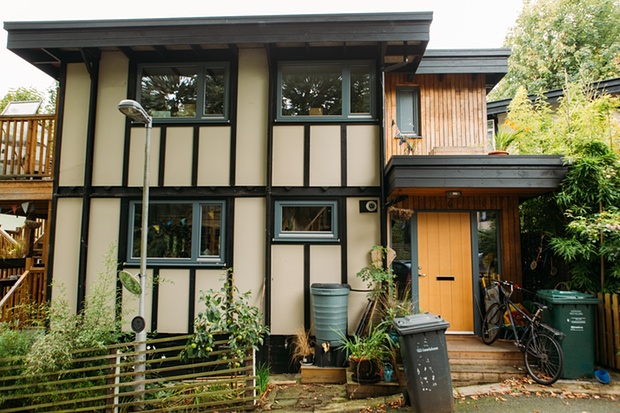How did innovative Winnipeg social housing, designed by one of Canada’s most talked about architecture firms, become a haven for drink and drugs?

Surreal quality … Centre Village, right, with Winnipeg’s more typical wood-framed gabled houses, left. Photograph: In Context
In photographs, Centre Village doesn’t look like the generic image of social housing. A playful cluster of stucco buildings surround a serene inner courtyard. Bold, orange-framed windows punctuate the white walls. Located as it is on a street in Winnipeg, Canada – and sandwiched on either side by that city’s typical modest, gable-roof houses – Centre Village has an almost surreal quality.
In person, however, the image quickly changes. The window blinds, for example, are closed on the windows that face into the courtyard. Litter is scattered across the ground. Speak to residents, and a new picture emerges: of apartments poorly suited to family life, and a building structure that seems to act as a magnet for drinking and drug-taking at all hours.
In May last year, I travelled with my colleague, Andrea Lacalamita, to this bustling city in the Canadian prairies. We arrived expecting to make a documentary about the positive social impacts of this award-winning housing project, designed by one of Canada’s most celebrated young architecture firms.
Instead, we found a building project badly affected by crime, with families living in cramped and unsuitable conditions. We also discovered that it was no longer a co-operative, that the community group who initiated the project had become disenchanted and that the development was up for sale. What happened?
‘We should have done our homework’

The Canadian Museum for Human Rights (left) and Esplanade Riel Bridge in Winnipeg, Canada. Photograph: Alamy
The Centre Village story reveals a lot about what “designer social housing” can do in cities – and what it can’t.
The project is located in Central Park, a remarkably diverse neighbourhood in downtown Winnipeg. Each year, waves of immigrants and refugees arrive here from around the world. It is one of Canada’s poorest and most densely populated urban areas.
“Central Park, it’s kind of like being in the third world. There’s very little institutional presence,” said Bill Millar, the pastor at Knox United, the multi-faith church at the heart of the Central Park neighbourhood.
The average household income here is less than C$20,000 (about £9,900) annually, and nearly 90% of residents live in subsidised high-rise towers. Thousands more are on waiting lists for public housing. Although many new immigrants have large families, the chances of finding a vacant three-bedroom apartment are slim. Moreover, a large proportion of Central Park’s residents are devout Muslims whose faith prohibits paying interest on a loan, making it impossible to take on a mortgage from a traditional bank.

Children use the slides in Central Park, Winnipeg, one of Canada’s poorest urban neighbourhoods. Photograph: Alamy
n 2006, the Knox Centre – an organisation started by Millar to allow the church to take a more active civic role – took an interest. As part of their mission to partner with the local mosque and other community groups to “allow them to develop their own economy, make their own homes, work, develop their own businesses”, Millar and the Knox Centre approached a local group of Somali families.
Together, they came up with the idea for a bold new housing co-operative – one where residents would rent to own. The plan was to secure public financing for the first development, and then to use the revenue generated to fund more interest-free housing.
The group approached CentreVenture, an arms-length municipal government development agency that works on regeneration projects in downtown Winnipeg. Together, they founded Centre Village on a few empty plots of land.
The project was designed by 5468796 Architecture, a relatively new architecture practice that has enjoyed rave reviews since forming in 2007. The Globe and Mail called them “fearless,” saying they are “leading a new generation of local architects to invent a new city, and perhaps a new Canada, that gives innovative architecture a seat at the table”.
So far, so good. But more than a year into the design process, Manitoba Housing, the province’s funding agency, delivered a blow. Previous schemes for low-income housing in the inner city had been unsuccessful, and the agency was not willing to take the risk again. Although the group insisted that members of their co-operative would be scrutinised on the basis of their financial stability, it wasn’t enough to convince the province. It pulled the funding.
Millar admits, in retrospect, that the plan was naive. “We should have done our homework,” he said. “But it wasn’t just a do-gooder thing. We need home ownership in Central Park.”
So CentreVenture pressed on. It established a new financing partnership with Manitoba Housing, in which the project changed into a subsidised rental project. The new stipulated structure would require a much higher density: 25 homes, rather than the original six.
The design priorities also shifted dramatically. Colin Neufeld, a partner at 5468796 Architecture, says the new priority became how to balance the new higher-density apartments while still retaining most of the ground floor for shared public space.
“We believed desperately in community space for these buildings,” said Neufeld. “So here we have a site that has four times its density capacity, and we want to save half of it for kids to play in.”
Their solution was to design the housing units as narrow, three-storey walk-ups. The biggest four-bedroom unit is just 875 sq ft. Neufeld calls it a unique living choice that challenges conventional norms.
“We live big, and we think we should be living smaller,” he says. Small units encourage residents to spend more time outside, and give them a chance to rub shoulders with neighbours. “Just because we have seven months of winter, doesn’t mean you shouldn’t go outside,” he said. “That’s why it’s a courtyard, to [provide] shelter from the wind.”
In practice, the narrow living spaces and the enclosed courtyard proved problematic.
Tanjil Mahmud Raju arrived to Canada from Bangladesh in 2012 with his wife,Shamima Khan Sharna, and their son. After four months searching for a permanent home, they moved into one of Centre Village’s new three-storey, two-bedroom units.
“Sometimes we feel like we are in a small box,” Raju said. “The stairs are pretty tough for furniture. They are pretty thin, so there’s not enough space to move around.”
“I have to take everything to the second floor to eat because my kitchen is downstairs,” said Sharna. “It’s a big problem for us. It’s not possible to take everything and eat on the second floor every time. So when we want to eat together, we have to sit on the stairs and eat there, just beside my kitchen.”
Besides crowding, there is the local crime, which plagues much of Winnipeg’s downtown. With no direct sightlines through Centre Village, that communal inner courtyard has turned into a convenient spot for locals to drink and use drugs, hidden from the eyes of police.
“Winnipeg downtown is pretty much a crime-prone place, and a lot of drunk people walk around here during this time, specifically in summer,” Sharna says. “A lot of unknown people get through this corridor. If there was a gate, one here and one there, it could have been better I think. Especially at night. Because at night, we hear a lot of screaming going on. Drunk people pass through and sometimes they fight each other.”
I asked Neufeld if he would change the design of the courtyard, given the safety concerns reported by residents. He insisted that “that if you design for the worst case scenario, then the worst case scenario will happen”.
“Maybe we’re too idealistic, but you have to hope that it will be OK to design for the community,” he said.
Sticky fingers
But what does it mean to design for the community?
Martha Thorne, executive director of the Pritzker architecture prize and Dean of the IE School of Architecture and Design, argues that architects are facing new challenges in cities.
“It’s not enough to make community space and say, ‘People are going to see each other,’” Thorne said. “Architects really have to understand the context from the client – the cultural context, to the bigger context, to the economics, to the future of the residents who’ll live there.”
In the 1970s and 80s, German architect Walter Segal designed what is now a widely celebrated low-income housing development in south London. Families were provided with a simple, functional design that they could build and adapt to their needs with cheap, accessible materials. More than 30 years later, the same residents report that their community is strong and stable.
In Chile, Alejandro Aravena has developed a number of innovative affordable ownership housing projects designed to help families overcome poverty. Residents are given just the bare essentials of a house – the kitchen, the bathroom – but within a design that encourages residents to expand and build upon their home, increasing its value over time. The idea was that residents could eventually use their home as an asset to secure a loan for a small business, or to pay for better education for their children.

Their solution was to design the housing units as narrow, three-storey walk-ups. The biggest four-bedroom unit is just 875 sq ft. Neufeld calls it a unique living choice that challenges conventional norms.
In both cases, the needs of the residents were reflected in the design of their future homes.
“Communities know well what is the question that needs to be answered,” said Aravena. “We’ve had an incredible amount of cases when you thought you had the answer to the question, you arrive at the place and the family says, ‘Look, fine, we appreciate that … but this other thing is a real issue for us,’” he said. “There’s nothing worse than answering well the wrong questions.”
What went wrong in Winnipeg was not just about architecture, and 5468796 were stuck trying to make the best of a bad situation. The pulling out of government support to make Centre Village an actual co-operative changed the direction of the project. “It’s not the project we originally envisioned, or we saw a need for in the community,” said the Knox Centre’s Millar.
Centre Village currently houses 25 families, but this arrangement is not likely to last long. The managing group CentreVenture, burdened with the cost of keeping the place running, is desperate to sell.
“It’s time to get the peanut butter off our fingers,” said Ross McGowan, former chief executive and president of CentreVenture, who retired last year. He admits that a failure to understand the needs of the community took a considerable toll on the project.
“We could have done better,” said McGowan. “We all have a responsibility, as the owners, as the consulting team, as the province, as the city. Maybe that’s part of the issue: [we thought] ‘well, it’s just affordable housing, let’s not get too wound up about it.’”
In recent years, there have been breathless reports of Winnipeg’s “architectural renaissance”, boosted by a steady rise in construction in the downtown core. The Royal Architectural Institute of Canada’s annual festival saw the city’s trendy Exchange District buzzing with events, tours and exhibitions. 5468796 Architecture, along with local urbanism group Storefront MB, hosted the closing soiree – an elaborate “pop-up” dinner on a bridge, the Esplanade Riel. Some 1,200 guests were invited to dine on long tables that ran the length of the bridge, “to experience and discuss the power of architecture and design”.
It was well attended and well received. But it was a far cry from the reality of Centre Village, not much more than a mile away.
“For me, if it’s a true ‘renaissance’, it’ll be that the design actually then reflects the people,” Millar said. “It starts to be what the people need it to be.”
- Read 5468796 Architecture’s response to this article on the ArchDaily website
.
Por: Raja Moussaoui
Fuente: The Guardian
